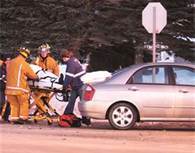Premiere for the North American Market: MESSRING Delivers Cutting-Edge Deceleration Crash Technology
 |
MUNICH--May 26, 2014: Hydrobrake with deceleration sled installed at Transport Canada's state-of-the-art test facility in Canada
Acceleration or deceleration? Or both? This question comes into play when engineers are planning a crash test facility and have to determine the most effective way of testing their vehicles and components. PMG Technologies, the firm responsible for managing the test facility for Transport Canada and for providing expert test services to international clients, has successfully integrated both technologies since March 31, 2014. PMG Technologies worked closely with MESSRING to plan and install the highly precise MESSRING propulsion system in 2011. The crash lab, which measures 5,300 m² and includes the capability of conducting moving car to moving car frontal, side and oblique impact crash tests is considered to be one of the world's most sophisticated crash test facilities. The acquisition of a deceleration sled from the crash test specialists in Bavaria has expanded the testing capacity and capability of sled test services offered by PMG Technologies. One of the benefits of the deceleration crash technology is that the direction of movement is synchronous with the crash rather than inverse, as is the case with acceleration tests.
Sled systems are used around the world to test the safety of vehicle components. Both systems (acceleration and deceleration) offer their own benefits. But many non-destructive crash tests can be simulated with greater precision using a Hydrobrake (deceleration sled) or in a deceleration system alone. This applies in particular to pre-crash braking scenarios that are virtually impossible to simulate using an acceleration system. This system also delivers high reproducibility of crash test results, greater testing frequency, and precise sled braking. The Hydrobrake can be integrated into just about any existing crash test facility relatively easily. Because the system can be installed at an existing crash barrier, complex and costly construction work is usually unnecessary. It was possible to carry out tests one week after the upgrade work began in Blainville. MESSRING offers the Hydrobrake with two brake forces: 2.0 MN and 3.2 MN. Both models require little maintenance and are more affordable than comparable acceleration systems.
The principle of the product is relatively simple. The deceleration sled is accelerated by the propulsion system towards the Hydrobrake at the barrier. A wedge attached to the front of the sled enters the Hydrobrake between the two brake shoes. This causes the displacement of the upper brake piston into the hydraulic cylinder. The sled deceleration is precisely controlled by regulating the oil flow from the cylinder. A computer aided control generates the control curves for the servo-hydraulic valve from the desired curves. Therefore a controlled pressure occurs during the braking procedure. This pressure is a measure for the braking force that determines the deceleration progress. Straightforward control via the computer at the control station simplifies the various testing approaches of the Hydrobrake and saves a lot of time for the test engineers. Saved test runs can be compared, repeated, and optimized time and again. The entire Hydrobrake system can be operated by a single person and crash simulations can be repeated in just a few minutes.
Alain Bussières, President PMG Technologies, is looking forward to the new opportunities the Hydrobrake system will provide: "The addition of MESSRING's Hydrobrake sled represents a valuable addition to our test services and meets our stringent requirements for optimum precision, repeatability, and reliability. We appreciate the expertise and excellent services offered by MESSRING. We are extremely satisfied with Messring products and services."
The Messring Hydrobrake system was installed and tuned, in time to pass the final acceptance requirements at the end of March 2014 and the Hydrobrake is now fully operational. Other Hydrobrakes have been in use in China, India, and Europe for many years but the new programmable hydraulic deceleration system at the Transport Canada Motor Vehicle Test Center in Canada is the first of its kind in North America.
CEO of MESSRING Systembau GmbH Dierk Arp is delighted with the additional contract: "Many of our customers now recognize that, alongside an acceleration sled, a deceleration system such as the Hydrobrake offers significant benefits. For PMG and the Transport Canada cutting-edge crash test facility, which was named Crash Test Facility of the Year 2012, there is great added value in the broader range of services."
The facility in Canada is truly state-of-the art. Thanks to its unique construction, the propulsion system in Blainville can be used to simulate almost any type of accident imaginable - with perfect precision down to the millimeter. This not only applies to impacts with a stationary obstacle, but also collisions between two vehicles - at any desired angle between 90 and 180°. In addition to cars and trucks weighing up to 40 metric tons, significantly heavier rail vehicles such as locomotives and railcars can also be tested.
Video showing the use of the Hydrobrake: Hydrobrake
Videos on the crash test facility in Blainville: Crash Test in BLAINVILLE


